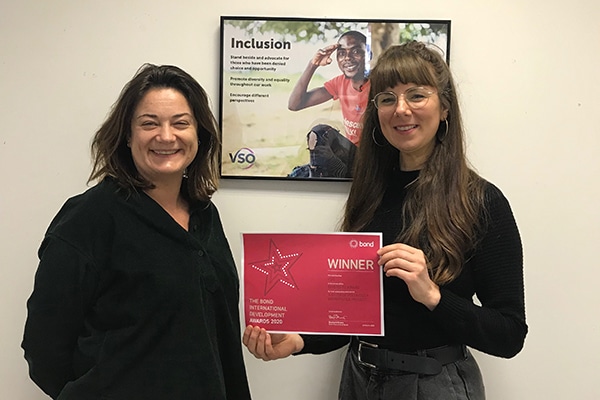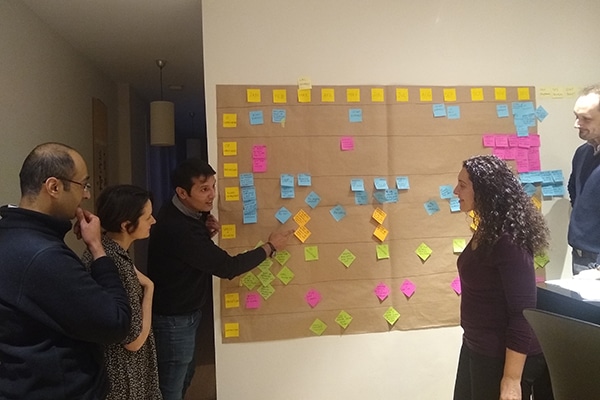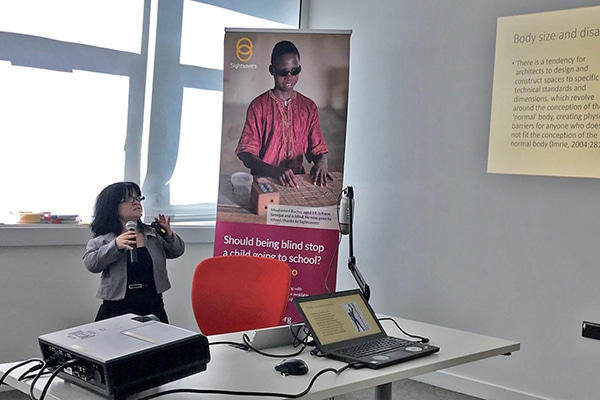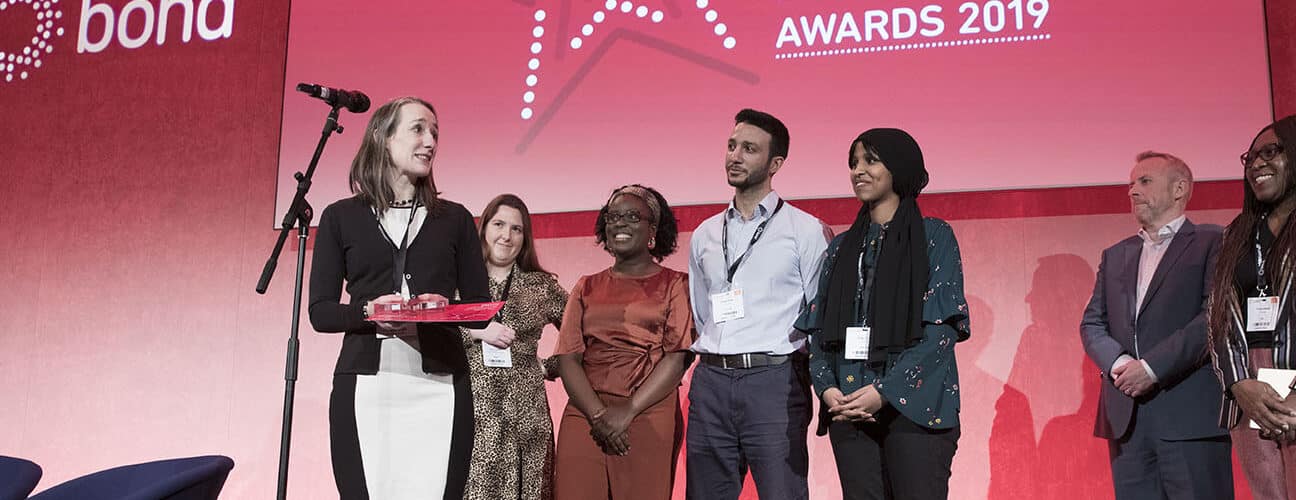Bond Diversity Award – and the winner is. . .
The Diversity Award shines a much-needed light on organisations that nurture diverse and inclusive workforces.
Congratulations to VSO for winning this prestigous award.
Below, you can see the shortlist of nominations. Click on the organisation to see what project or initiative they have submitted for this award.
Don’t forget to join in the conversation on social media using the #BondAwards tag.
Winner – VSO

VSO is so proud to have achieved this award for the International Citizen Service programme. Whilst we know people from diverse backgrounds can both contribute and gain so much from volunteering, for many this opportunity is something which has multiple barriers. We are proud of our work to remove these barriers, to ensure that everyone, no matter their identity, has the opportunity to access their rights, opportunities, realise their potential and support our work to tackle poverty and marginalisation.
VSO
As part of their organisational commitment to social inclusion, VSO recognises the unique value of ensuring a diverse range of volunteers are able to access and contribute to their work. The ICS programme for youth volunteers has developed practices to remove barriers for participation and ensure inclusion for all
Objectives for the project
- A diverse range of young people are given the opportunity to access the ICS programme.
- A diverse range of young people are included, integrated and able to participate on the programme on an equitable level
- Design inclusive programmes to facilitate the unique impact that diversity can have on project outcomes
How have people benefited?
Since 2016, 8,352 young people from the UK have participated as volunteers on the ICS programme. This year alone, VSO has reached young people across all demographics, meeting all their diversity targets, with 30% of applicants from BAME backgrounds, 37% meeting two or more socio-economic indicators, 19% of applicants stating a disability, and achieving regional representation across the four nations of the United Kingdom.
The impact of this diverse workforce has been seen within VSO projects, for example through working with disabled volunteers to empower disabled people, and across different cultural landscapes.
What examples are there of a cultural shift?
- Enhanced reach. 30% of ICS applications are from BAME backgrounds, and 37% meet two or more indicators relating to socio-economic diversity, such as having accessed free school meals, or living in a household with income less than £20,000. Through their commitment to diversity, VSO have ensured that international development opportunities can be accessed by all.
- Improving duty of care, safeguarding and security to ensure participation for all. This includes providing training and raising awareness to all about the different experiences that different identities have depending on the culture and environment they are in.
- Helping deaf volunteers. As part of VSO’s Disability Programming initiative, Deaf volunteers from the UK and Kenya have been working together to champion disability rights, empower Deaf community members, and tackle the existing stigma of being Deaf in Kenya.
How will the initiative remain sustainable?
Inclusion starts right at the beginning of the volunteer experience, from the moment they come into contact with the opportunities available. VSO’s approach to social inclusion and gender is part of the organisation and is a key touchstone method to delivering change. The trainings on social inclusion and gender for all staff have enabled staff to become more sensitive to the issues of exclusion.
VSO’s recruitment process reflects the approach they take to attract staff and volunteers from diverse background upholding social inclusion at the core. This ethos follows volunteers through the journey, with dedicated support plans, staff trained in inclusive practice, and the option to apply for additional funding to remove barriers and increase participation.
Monitoring data, VSO assess the conversion of groups from application to completion, this process identifies excluded demographics and informs where they target their resources and efforts to remove barriers.
Diversity Award shortlist
Save the Children – Global Gender and Diversity Safety and Security

Individual characteristics such as sex, gender identity and expression, sexual orientation, ethnicity, disabilities play an important role in a person’s safety and security. “Gender and Diversity Safety and Security” is a Save the Children initiative that aims at enhancing an inclusive system for staff in 120 countries around the world.
Project objectives
- The revision of the global safety and security travels’ tools.
- The adaptation of procedures in countries of operations with a gender and diversity lens.
- Capacity building of the Safety and Security Focal Points (SSFPs) on Inclusive Safety and Security Management.
How have people benefited?
Globally, Save the Children’s workforce is made-up of around 24,000 staff working in more than 120 countries. With this initiative, they reached the entire workforce, considering that all staff travelling to a country of operations receive pre-departure information (PDIs). Reading the PDI is mandatory: an auto-declaration of having read the PDI is a pre-requisite to issue a flight ticket. Additionally, the PDIs, as well as other awareness raising tools on individuals risk profile, are available on the Save the Children intranet.
The Safety and Security Focal Points (SSFPs) are responsible to give security briefing to all staff, make security assessment and plans, select offices and accommodation.
Save the Children reached all 120 Country Offices SSFPs, with a benefit for the entire workforce.
What examples are there of a cultural shift?
- Safety and Safety Focal Points of Asia, Middle East, Africa, Latin America were asked to review the pre-departure information and the face-to-face briefings of their countries for integrating diverse profiles. This has created a cultural shift in the way the Safety and Security focal points consider the duty of care for staff with an inclusive approach.
- The capacity building to Safety and Security Focal Points and the awareness raising to all staff on individuals risk profile, put the attention on how personal characteristics and their intersectionality interplay with the local contexts to influence vulnerabilities and exposure to risks. This is a cultural shift from the classic Safety and Security trainings valid for everyone and “diversity” blind.
- This initiative created a cultural shift on the way of thinking within the Organisation itself, being global, connected with other functions and with staff lead networks and working groups, that the initiative itself contributed to create.
How is this project sustainable?
Save the Children’s initiative is mainly self-sustainable considering that one of the key objective is the capacity building of local Safety and Security Focal Points. From the global level, they empower the Regional and Country level, making sure the localisation of this initiative happens from the real onset.
Save the Children approached the initiative in a cross-functional way, working in collaboration with many internal stakeholders to ensure a lasting cultural change.
They are integrating a gender and diversity lens directly into existing policies, operating procedures andtools. This means that the global budget dedicated to Safety and Security will have Gender and Diversity considerations already embedded in it, at global regional and country level.
Additionally, they rely on the engagement and support of the Save the Children Associated Members and have the buy-in of the Senior Leadership Team.
Sightsavers – Social Inclusion Working Group

The SIWG promotes and supports disability in the workplace in order to deliver on Sightsavers’ strategic objective to become an employer of choice for people with disability and obtain disability confident level 3.
Project objectives
- Raise awareness.
- Build capacity.
- Drive positive change.
How have people benefitted?
As a global organisation of over 550 staff, all of Sightsavers’ efforts are designed to reach out to their 26 country offices as well as HQ. The speakers programme is broadcast via internet and they have many global staff participating. There are regional representatives on the group and they regularly participate in regional management team meetings to engage with global staff. It is recognised that more does need to be done.
Since much of what they are promoting at a global levels comes from HQ and they are based in the UK, Sightsavers is guided by the UK’s Equality Act. In Country offices, legislation is different and country directors and country staff must reflect on their national contexts. They have expanded their staffing and now have more regionally based staff who will also support global capacity building in this area.
What examples are there of a cultural shift?
- Through the membership which represents all teams in the organisation, including programme, research, corporate services, HR and design, Sightsavers have been able to tackle a range of barriers that may exist for people with disabilities within an institution.
- Sightsavers is now a more aware organisation which is practicing what they preach – and this is having a positive impact on attracting and recruiting people with disabilities into the organisation.
- They set up an accountability mechanism whereby the SIWG reports on a regular basis to the Senior Management Team. Sightsavers also have a focal point on their board of trustee, which has enabled disability inclusion to be embedded into managament thinking and decision making.
How is this project sustainable?
Sightsavers anticipate that the SIWG efforts will endure after the work has concluded, because they are embedding initiatives in existing structures. HR plays a hugely important role, the security teams and corporate services have put in place supportive systems for new and existing staff. Communications accessibility is also embedded in other teams. The SIWG is also establishing a disabled employees network (DEN) and they envisage this structure will play an important role moving forwards in ensuring the specific practical and strategic interests of disabled staff are met.

